Should the investors of the Passerine development at Guana Cay, Abaco violate the Environmental Impact Assessment [EIA] and the proposed Environmental Management Plan [EMP], the project will be stopped, according to the Heads of Agreement that was made public this week.
The Bahamas Environment Science and Technology Commission [BEST] has approved a $24 million 240-slip marina and a $12 million 18-hole golf course for the Passerine at Abaco project, despite strenuous concerns about an environmental catastrophe.
But a condition of the commencement of the construction is the completion of a favourable EIA and EMP.
“Any work undertaken by the developer, in violation of the EIA and the EMP without the approval of BEST, shall be stopped, the agreement stated.
BEST’s endorsement was outlined in the 46 page Heads of Agreement that the Minister of Financial Services and InvestmentsAllyson Maynard-Gibson tabled in the House of Assembly on Wednesday night.
The document itemized the specifics of the terms and conditions under which the phased development, inclusive of a villa hotel, is projected to progress over the next five years.
But it also tied the Passerine and Baker’s Bay developers to correcting any environmental damage that might occur as a result.
“The developers undertake to maintain and preserve the environmental and ecological integrity of the development in accordance with the conditions and obligations stipulated by the BEST Commission and or the Minister responsible for environmental services and in the event of any failure of such undertaking, the developers shall be responsible and liable for remedying, correcting and mitigating the consequences rising from the failure of such undertaking, the agreement noted.
But such commitments have not placated anxious Guana Cay residents who took their objections to another level this week as they staged a protest in downtown Nassau. They have repeated concerns about the construction of the marina and golf course destroying the nearby barrier reef, which is said to be the third largest in the world.
Those residents formed the Save Guana Cay Reef group and have even retained Grand Bahama attorney Fred Smith to have the development stopped. He has threatened to entangle the project in litigation.
Passerine executives have already submitted the EIA, as was required by BEST. Under the agreement, they will also pay for an expert, nominated by BEST, to evaluate that EIA and pay for the monitoring of the development by the relevant government agencies during construction, commissioning and decommissioning.
According to the pact, the developers have committed to making substantial progress on the clearing of the site and the initial construction of the marina, golf course and villa hotel within twelve months of the signing of the agreement which occurred on March 1, 2005.
Prime Minister Perry Christie in parliament this week hailed the Heads of Agreement with Passerine as a model for other such documents. A key feature is the preservation of 66 acres of wetlands, flats and creeks on Guana Cay which will be protected under a foundation for research and educational purposes.
According to the agreement: “The Preserve is not to be developed in the future other than to include walking trails and boat observation sites through the Preserve which trails shall be approved by the Ministry of Health in consultation with the Bahamas National Trust, the University of Miami and the Institute for Marine Science at the College of the Bahamas and built by the developers/foundation at their own expense and be open to the public and the members of the community.
The Minister of Financial Services and Investments Allyson Maynard Gibson, on tabling the agreement, insisted that the government has consulted with the cay’s residents on the matter, contrary to what many of them have said.
She referred to a meeting that was held on February 20th that the developers, environmental consultants, technical representatives and government officials attended.
As for the concerns that have been raised about the golf course and marina adversely impacting the reef and marine life, Minister Maynard-Gibson said that coastal buffers from the crest of the dune system would be put in place to mitigate the impact. Additionally it is proposed that the golf course would be built in stages.
“No damage is expected as there will be an environmental management plan in place, she said. “The government is in discussions with Coastal Systems International Inc., a well known U.S. company of coastal engineers and environmental planners to act as a consultant to BEST.
Dr. Michael Risk, a marine biologist who has been working in coral reef environments for 40 years has produced a report on the proposed development which points to the potential for a marina of the size proposed for Guana Cay becoming a cesspool, being a breeding ground for human pathogens and wiping out the bonefish flats in the adjacent bay.
He even recommended that developers should come up with a plan to compensate Bahamians for the loss of their traditional fishing and crabbing grounds.
Dr. Risk said he was provided a copy of the developers’ Environmental Impact Assessment and found it strangely lacking in detail on the marine environment.
Developers have said that they plan to replace invasive species with more appropriate native vegetation, use native plants, recycled water on the golf course and cut down on the use of fertilizers and pesticides.
But Abaco residents like Troy Albury who operates a dive operation at Guana Cay took no comfort in those reassurances.
“We are not going away because they signed the agreement, said Mr. Albury, who is also a member of the Save Guana Cay Reef lobby. “It’s not a done deal.
The group has collected more than 80 signatures on a petition against the development.
The cay is home to just under 200 residents, many of whom are second homeowners.
By: Tameka Lundy, The Bahama Journal



